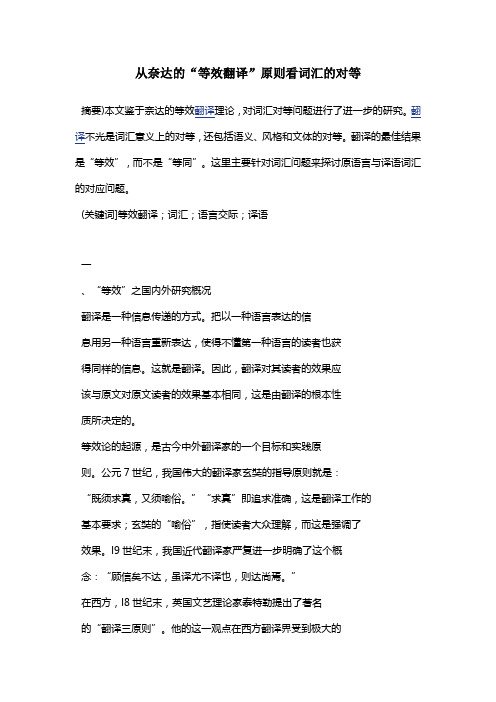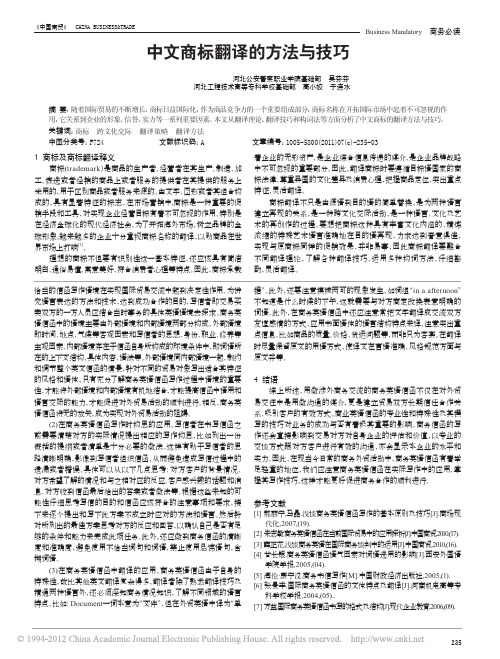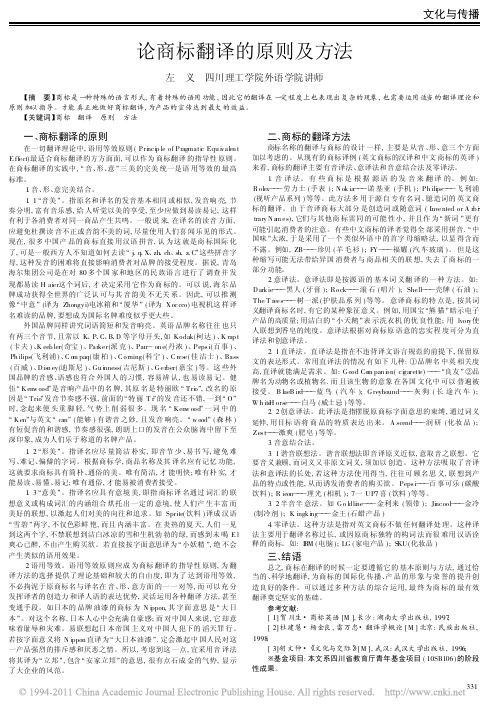等效原理与商标词的翻译
- 格式:doc
- 大小:34.50 KB
- 文档页数:4

从奈达的“等效翻译”原则看词汇的对等摘要)本文鉴于奈达的等效翻译理论,对词汇对等问题进行了进一步的研究。
翻译不光是词汇意义上的对等,还包括语义、风格和文体的对等。
翻译的最佳结果是“等效”,而不是“等同”。
这里主要针对词汇问题来探讨原语言与译语词汇的对应问题。
(关键词]等效翻译;词汇;语言交际;译语一、“等效”之国内外研究概况翻译是一种信息传递的方式。
把以一种语言表达的信息用另一种语言重新表达,使得不懂第一种语言的读者也获得同样的信息。
这就是翻译。
因此,翻译对其读者的效果应该与原文对原文读者的效果基本相同,这是由翻译的根本性质所决定的。
等效论的起源,是古今中外翻译家的一个目标和实践原则。
公元7世纪,我国伟大的翻译家玄奘的指导原则就是:“既须求真,又须喻俗。
”“求真”即追求准确,这是翻译工作的基本要求;玄奘的“喻俗”,指使读者大众理解,而这是强调了效果。
l9世纪末,我国近代翻译家严复进一步明确了这个概念:“顾信矣不达,虽译尤不译也,则达尚焉。
”在西方,l8世纪末,英国文艺理论家泰特勒提出了著名的“翻译三原则”。
他的这一观点在西方翻译界受到极大的重视。
而同时他讲到的另一段话则更为重要。
他指出,在好的翻译中,原著的优点已经完全移注到了另一种语言中,使得另一种语言所属国家的读者大众能够获得清楚的理解和强烈的感受,其程度和使用原著语言的人相等。
泰特勒在这里明确提出了两种接受者的感受应该相等,这正是等效概念的关键。
1931年,我国革命翻译家瞿秋白提出了截至当时最为全面的等效概念。
他指出,翻译应该把原文的本意完全正确地介绍给中国读者,使中国读者所得到的概念等于他国读者的所得。
卡特福德,英国的语言学派翻译理论代表,最早提出了“等值翻译”概念。
他认为,翻译实践的中心任务是在译语中“寻找等值体”,翻译理论的实质是描述翻译等值的机制。
二、奈达的“等效翻译”原则美国著名翻译理论家奈达于1964年在其著作《翻译科学初探)(Towards a Science ofTranslating)中也提出了“等效翻译理论”。

电工常用词汇中英文翻译]电路的基本概念及定律电源source电压源voltage source电流源current source理想电压源ideal voltage source理想电流源ideal current source伏安特性volt-ampere characteristic电动势electromotive force电压voltage电流current电位potential电位差potential difference欧姆Ohm伏特Volt安培Ampere瓦特Watt焦耳Joule电路circuit电路元件circuit element电阻resistance电阻器resistor电感inductance电感器inductor电容capacitance电容器capacitor电路模型circuit model参考方向reference direction参考电位reference potential欧姆定律Ohm’s law基尔霍夫定律Kirchhoff’s law基尔霍夫电压定律Kirchhoff’s voltage law(KVL)基尔霍夫电流定律Kirchhoff’s current law(KCL)结点node支路branch回路loop网孔mesh支路电流法branch current analysis网孔电流法mesh current analysis结点电位法node voltage analysis电源变换source transformations叠加原理superposition theorem网络network无源二端网络passive two-terminal network 有源二端网络active two-terminal network 戴维宁定理Thevenin’s theorem诺顿定理Norton’s theorem开路(断路)open circuit短路short circuit开路电压open-circuit voltage短路电流short-circuit current交流电路直流电路direct current circuit (dc)交流电路alternating current circuit (ac)正弦交流电路sinusoidal a-c circuit平均值average有效值effective均方根值root-mean-squire (rms)瞬时值instantaneous电抗reactance感抗inductive reactance容抗capacitive reactance法拉Farad亨利Henry阻抗impedance复数阻抗complex impedance相位phase初相位initial phase相位差phase difference相位领先phase lead相位落后phase lag倒相,反相phase inversion频率frequency角频率angular frequency赫兹Hertz相量phasor相量图phasor diagram有功功率active power无功功率reactive power视在功率apparent power功率因数power factor功率因数补偿power-factor compensation串联谐振series resonance并联谐振parallel resonance谐振频率resonance frequency频率特性frequency characteristic幅频特性amplitude-frequency response characteristic相频特性phase-frequency response characteristic截止频率cutoff frequency品质因数quality factor通频带pass-band带宽bandwidth (BW)滤波器filter一阶滤波器first-order filter二阶滤波器second-order filter低通滤波器low-pass filter高通滤波器high-pass filter带通滤波器band-pass filter带阻滤波器band-stop filter转移函数transfer波特图Bode diagram傅立叶级数Fourier series三相电路三相电路three-phase circuit三相电源three-phase source对称三相电源symmetrical three-phase source对称三相负载symmetrical three-phase load相电压phase voltage相电流phase current线电压line voltage线电流line current三相三线制three-phase three-wire system三相四线制three-phase four-wire system三相功率three-phase power星形连接star connection(Y-connection)三角形连接triangular connection(D- connection ,delta connection) 中线neutral line电路的暂态过程分析暂态transient state稳态steady state暂态过程,暂态响应transient response换路定理low of switch一阶电路first-order circuit三要素法three-factor method时间常数time constant积分电路integrating circuit微分电路differentiating circuit磁路与变压器磁场magnetic field磁通flux磁路magnetic circuit磁感应强度flux density磁通势magnetomotive force磁阻reluctance电动机直流电动机dc motor交流电动机ac motor异步电动机asynchronous motor同步电动机synchronous motor三相异步电动机three-phase asynchronous motor 单相异步电动机single-phase asynchronous motor 旋转磁场rotating magnetic field定子stator转子rotor转差率slip起动电流starting current起动转矩starting torque额定电压rated voltage额定电流rated current额定功率rated power机械特性mechanical characteristic继电器-接触器控制按钮button熔断器fuse开关switch行程开关travel switch继电器relay接触器contactor常开(动合)触点normally open contact常闭(动断)触点normally closed contact时间继电器time relay热继电器thermal overload relay中间继电器intermediate relay可编程控制器(PLC)可编程控制器programmable logic controller语句表statement list梯形图ladder diagram半导体器件本征半导体intrinsic semiconductor掺杂半导体doped semiconductorP型半导体P-type semiconductorN型半导体N--type semiconductor自由电子free electron空穴hole载流子carriersPN结PN junction扩散diffusion漂移drift二极管diode硅二极管silicon diode锗二极管germanium diode阳极anode阴极cathode发光二极管light-emitting diode (LED)光电二极管photodiode稳压二极管Zener diode晶体管(三极管)transistorPNP型晶体管PNP transistorNPN型晶体管NPN transistor发射极emitter集电极collector基极base电流放大系数current amplification coefficient场效应管field-effect transistor (FET)P沟道p-channelN沟道n-channel结型场效应管junction FET(JFET)金属氧化物半导体l-oxide semiconductor (MOS)耗尽型MOS场效应管depletion mode MOSFET(D-MOSFET)增强型MOS场效应管enhancement mode MOSFET(E-MOSFET)源极source栅极grid漏极drain跨导transconductance夹断电压pinch-off voltage热敏电阻thermistor开路open短路shorted基本放大器放大器amplifier正向偏置forward bias反向偏置backward bias静态工作点quiescent point (Q-point)等效电路equivalent circuit电压放大倍数voltage gain总的电压放大倍数overall voltage gain饱和saturation截止cut-off放大区amplifier region饱和区saturation region截止区cut-off region失真distortion饱和失真saturation distortion截止失真cut-off distortion零点漂移zero drift正反馈positive feedback负反馈negative feedback串联负反馈series negative feedback并联负反馈parallel negative feedback共射极放大器common-emitter amplifier射极跟随器emitter-follower共源极放大器common-source amplifier共漏极放大器common-drain amplifier多级放大器multistage amplifier阻容耦合放大器resistance-capacitance coupled amplifier 直接耦合放大器direct- coupled amplifier输入电阻input resistance输出电阻output resistance负载电阻load resistance动态电阻dynamic resistance负载电流load current旁路电容bypass capacitor耦合电容coupled capacitor直流通路direct current path交流通路alternating current path直流分量direct current component交流分量alternating current component变阻器(电位器)rheostat电阻(器)resistor电阻(值)resistance电容(器)capacitor电容(量)capacitance电感(器,线圈)inductor电感(量),感应系数inductance正弦电压sinusoidal voltage集成运算放大器及应用差动放大器differential amplifier运算放大器operational amplifier(op-amp)失调电压offset voltage失调电流offset current共模信号common-mode signal差模信号different-mode signal共模抑制比common-mode rejection ratio (CMRR) 积分电路integrator(circuit)微分电路differentiator(circuit)有源滤波器active filter低通滤波器low-pass filter高通滤波器high-pass filter带通滤波器band-pass filter带阻滤波器band-stop filter波特沃斯滤波器Butterworth filter切比雪夫滤波器Chebyshev filter贝塞尔滤波器Bessel filter截止频率cut-off frequency上限截止频率upper cut-off frequency下限截止频率lower cut-off frequency中心频率center frequency带宽Bandwidth开环增益open-loop gain闭环增益closed-loop gain共模增益common-mode gain输入阻抗input impedance电压跟随器voltage-follower电压源voltage source电流源current source单位增益带宽unity-gain bandwidth频率响应frequency response频响特性(曲线)response characteristic波特图the Bode plot稳定性stability补偿compensation比较器comparator迟滞比较器hysteresis comparator阶跃输入电压step input voltage仪表放大器instrumentation amplifier隔离放大器isolation amplifier对数放大器log amplifier反对数放大器antilog amplifier反馈通道feedback path反向漏电流reverse leakage current相位phase相移phase shift锁相环phase-locked loop(PLL)锁相环相位监测器PLL phase detector和频sum frequency差频difference frequency波形发生电路振荡器oscillatorRC振荡器RC oscillatorLC振荡器LC oscillator正弦波振荡器sinusoidal oscillator三角波发生器triangular wave generator方波发生器square wave generator幅度magnitude电平level饱和输出电平(电压)saturated output level功率放大器功率放大器power amplifier交越失真cross-over distortion甲类功率放大器class A power amplifier乙类推挽功率放大器class B push-pull power amplifier OTL功率放大器output transformerless power amplifier OCL功率放大器output capacitorless power amplifier直流稳压电源半波整流full-wave rectifier全波整流half-wave rectifier电感滤波器inductor filter电容滤波器capacitor filter串联型稳压电源series (voltage) regulator开关型稳压电源switching (voltage) regulator集成稳压器IC (voltage) regulator晶闸管及可控整流电路晶闸管thyristor单结晶体管unijunction transistor(UJT)可控整流controlled rectifier可控硅silicon-controlled rectifier峰点peak point谷点valley point控制角controlling angle导通角turn-on angle门电路与逻辑代数二进制binary二进制数binary number十进制decimal十六进制hexadecimal二-十进制binary coded decimal (BCD)门电路gate三态门tri-state gate与门AND gate或门OR gate非门NOT gate与非门NAND gate或非门NOR gate异或门exclusive-OR gate反相器inverter布尔代数Boolean algebra真值表truth table卡诺图the Karnaugh map逻辑函数logic逻辑表达式logic expression组合逻辑电路组合逻辑电路combination logic circuit译码器decoder编码器coder比较器comparator半加器half-adder全加器full-adder七段显示器seven-segment display时序逻辑电路时序逻辑电路sequential logic circuitR-S 触发器R-S flip-flopD触发器D flip-flopJ-K触发器J-K flip-flop主从型触发器master-slave flip-flop置位set复位reset直接置位端direct-set terminal直接复位端direct-reset terminal寄存器register移位寄存器shift register双向移位寄存器bidirectional shift register 计数器counter同步计数器synchronous counter异步计数器asynchronous counter加法计数器adding counter减法计数器subtracting counter定时器timer清除(清0)clear载入load时钟脉冲clock pulse触发脉冲trigger pulse上升沿positive edge下降沿negative edge时序图timing diagram波形图waveform脉冲波形的产生与整形单稳态触发器monostable flip-flop双稳态触发器bistable flip-flop无稳态振荡器astable oscillator晶体crystal555定时器555 timer模拟信号与数字信号的相互转换模拟信号analog signal数字信号digital signalAD转换器analog -digital converter (ADC)DA转换器digital-analog converter (DAC)半导体存储器只读存储器read-only memory(ROM)随机存取存储器random-access memory(RAM)可编程ROM programmable ROM(PROM)。

恰当的信函写作语境在实现国际贸易交流中起到决定性作用。
为讲究语言表达的方法和技术,达到成功合作的目的,写信者即交易买卖双方的一方人员应结合当时事务的具体英语语境去探求。
商务英语信函中的语境主要由外部语境和内部语境两部分构成。
外部语境即时间、地点、气候等客观因素和写信者的思想、身份、职业、修养等主观因素。
内部语境存在于信函自身所构成的环境条件中,即词语所在的上下文结构、具体内容、语法等。
外部语境同内部语境一起,制约和调节整个英文信函的情景,针对不同的贸易对象写出适合其特征的风格和语体,只有充分了解商务英语信函写作过程中语境的重要性,才能将外部语境和内部语境有机地结合,才能提高信函中语用和语言交际的能力,才能促进对外贸易活动的顺利进行。
相反,商务英语信函将无的放矢,成为实现对外贸易活动的阻碍。
(2)在商务英语信函写作时构思的应用。
写信者在书写信函之前需要清楚对方的实际情况提出相应的写作构思,比如列出一份概括的提纲或者清单是十分必要的做法。
这样有助于写信者的思路清晰明确,影像到写信者组织信函,从而避免造成写信过程中的遗漏或者错误。
具体可以从以下几点思考:对方客户的背景情况、对方希望了解的情况和与之相对应的反应、客户感兴趣的话题和消息、对方收到信函最后给出的答案或者做法等。
根据这些未知的可能性仔细思考写信的目的和信函应该符合的注意事项和要求。
接下来逐个提出和写下此方案不成立时应对的方法和语言。
然后针对所列出的最佳方案思考对方的反应和回答,以确认自己是否有足够的条件和能力来完成此项任务。
此外,还应做到商务信函的清晰度和准确度,避免使用不恰当词句和词语,禁止使用忌讳语句,含糊词语。
(3)在商务英语信函中翻译的应用。
商务英语信函由于自身的特殊性,故比其他英文翻译复杂得多,翻译者除了熟悉翻译技巧及精通两种语言外,还必须深知商务情况知识,了解不同领域的语言特点。
比如:Document一词本意为“文件”,但在外贸英语中译为“单据”。

论商标翻译的原则及方法左 义 四川理工学院外语学院讲师摘 要 商标是一种特殊的语言形式,有着特殊的语用功能,因此它的翻译在一定程度上也表现出复杂的现象,也需要运用适当的翻译理论和原则加以指导。
才能真正地做好商标翻译,为产品的宣传达到最大的效益。
关键词 商标 翻译 原则 方法一、商标翻译的原则在一切翻译理论中,语用等效原则(Pri nci p le of Pragmati c Equ i val en t E ff ect)最适合商标翻译的方方面面,可以作为商标翻译的指导性原则。
在商标翻译的实践中, 音、形、意 三美的完美统一是语用等效的最高标准。
1.音、形、意完美结合。
1.1 音美 。
指原名和译名的发音基本相同或相似,发音响亮,节奏分明,富有音乐感,给人听觉以美的享受,至少应做到易读易记,这样有利于各消费者对同一商品产生共鸣。
一般说来,在译名的读音方面,应避免杜撰读音不正或音韵不美的词,尽量使用人们喜闻乐见的形式。
现在,很多中国产品的商标直接用汉语拼音,认为这就是商标国际化了,可是一般西方人不知道如何去读 j、q、X、zh、ch、s h、z、C 这些拼音字母,这种发音的困难将直接影响消费者对品牌的接受程度。
据说,青岛海尔集团公司是在对80多个国家和地区的民族语言进行了调查并发现都易读H ai er这个词后,才决定采用它作为商标的。
可以说,海尔品牌成功获得全世界的广泛认可与其音韵美不无关系。
因此,可以推测像 中意 (译为Zhongyi)电冰箱和 厦华 (译为Xoccco)电视机这样译名难读的品牌,要想成为国际名牌难度似乎更大些。
外国品牌同样讲究词语简短和发音响亮。
英语品牌名称往往也只有两三个音节,且常以K、P、C、B、D等字母开头,如Kodak(柯达)、K rap t (卡夫)、K eeb ler(奇宝)、Parker(派克)、Pan on e(丹浓)、Peps i(百事)、Ph ilips(飞利浦)、C o m paq(康柏)、C orning(科宁)、C res e(佳洁士)、Bass (百威)、Dis n ey(迪斯尼)、Gu i nness(吉尼斯)、Gerber(嘉宝)等。

Wide Angle | 广角MODERN BUSINESS现代商业266中英文商标名称的互译李林颖 湖南工业大学 412007摘要:品牌名称的翻译是跨文化交流的一种形式。
然而,我们把中文商标翻译成英文或把英文商标翻成中文,将会涉及到语言、法律、文化心理、审美情趣和其他一些因素。
翻译者也应注意一些文化禁忌并选择适当的方法来翻译。
当然,品牌翻译不是一件简单的事情。
我们翻译商品名称时,尽可能做到力求完美。
一个好的商品添加一个好名字它的魅力是无穷的。
关键词:中英文商标; 文化; 译法; 禁忌国内国际商业经营中,各类商品都有商标,注册后的商标成为某种产品的专有名字。
人类进入21世纪,国际贸易发展迅速。
当商业合作和进出口规模不断扩大时,国家的边界逐渐淡化。
除了广告媒介,进口和出口的产品是否可以在国外的土地上成功开发市场,品牌名称的翻译正扮演着关键的角色。
商品品牌的名称类似人的名字。
翻译的品牌名称是商品在其他国家的第二名字,其重要性不言而喻。
一、品牌名称的翻译原则一个成功的翻译品牌既要保留原有文字的本质,还要具有与原文相同的影响力,在必须符合消费者名牌心理的同时,还要注意到英语和汉语的文化差异。
(一)品牌名称翻译的广告性质原则翻译后的品牌名称必须确定产品的性质和特点,体现原有的本土化概念,在原文的基础上,起着广泛传播的作用。
同时,译后名称必须符合商品的特性,简洁新颖,发音甜美。
有利于拼、读、写和记忆,并容易使消费者理解,并对商品产生好的印象。
例如,“Dynasty”——英文商标是“皇朝葡萄酒”,让我们不禁联想其古老而神秘的东方国家,因此,我们对良好的陈酒产生好的印象。
“Forever”是“永久自行车”的商标,它符合自行车完美的“经久耐用,直到永远”的广告。
“飞鸽自行车”翻译成“Flying Pigeon”,鸽子是和平的象征,“flying”使自行车的特性变得生动。
“蜂花化妆品”翻译成Bee&Flower”,我们用了以后会感觉舒适和芳香。

汽车品牌名称的翻译跟等效原则在汽车行业中,汽车品牌名称的翻译是非常重要的,它直接关系到品牌的传播和市场认知。
汽车品牌名称的翻译需要遵循一定的等效原则,以确保翻译的准确性和可接受性。
本文将详细介绍汽车品牌名称翻译的等效原则,以帮助方案撰写专家更好地完成相关任务。
1. 保持音译与意译的平衡在汽车品牌名称的翻译中,音译和意译是两种常见的翻译方法。
音译是指将源语言的音素转化为目标语言的音素,以保持名称的发音特点。
意译是指根据品牌名称的含义和形象,选择与之相符的目标语言词汇进行翻译。
在选择翻译方法时,需要保持音译与意译的平衡。
对于一些具有特定含义和形象的品牌名称,可以使用意译的方法进行翻译,以更好地传达品牌的核心价值和特点。
而对于一些无特定含义但发音独特的品牌名称,则可以采用音译的方法进行翻译,以保持名称的可辨识性和一致性。
2. 尊重品牌特点和文化背景汽车品牌名称往往具有独特的特点和文化背景,这些特点和背景是品牌的核心价值所在。
在翻译汽车品牌名称时,需要尊重品牌的特点和文化背景,避免对其进行过度的改动和调整。
在尊重品牌特点和文化背景的基础上,可以进行适当的翻译调整。
例如,对于一些具有地域特色的品牌名称,可以在翻译时保留其地域特点,以增强品牌的认知度和市场竞争力。
同时,还可以根据目标市场的文化背景,进行适当的本土化翻译,以更好地适应当地消费者的需求和喜好。
3. 确保翻译的简洁明了汽车品牌名称的翻译应该是简洁明了的,以便于消费者的记忆和传播。
翻译时应尽量避免过长或复杂的名称,以免给消费者造成困扰和记忆负担。
在翻译汽车品牌名称时,可以采用缩写或简化的方式进行翻译,以减少名称的长度和复杂度。
同时,还可以选择具有简洁明了含义的目标语言词汇进行翻译,以增强品牌名称的可读性和可理解性。
4. 避免与已有品牌名称冲突在翻译汽车品牌名称时,需要避免与已有品牌名称产生冲突。
冲突的品牌名称可能导致品牌形象的混淆和市场竞争的不利。
功能对等理论视角下商标名称的翻译研究Translation Strategies of Brand Name from the Perspective of FunctionalEquivalenceAbstractBrand name is important for the success of a product. A good brand name can bring endless profits and a bad one can only lead to the collapse of the manufacturer. In a time where international trade and exchange are more and more frequent, and international competitions are more and more vehement. An entrepreneur that struggles to make profits must be care of the brand name translation. With the brand name gaining its weight in the international trade, the study of translation of the brand name also becomes a major concern of the theorist and translation practitioners.The study of the translation of brand name in this thesis is made under the light of functional equivalence theory proposed by Nida. This is because that one of the major function of brand name is to persuade the consumers to trust the high quality of the product and take actions. This is in line with the essence of the functional equivalence theory, which take the relationship between the consumer and the translation. This thesis will discuss the basic rules and principle of brand names and then analyze the translation methods of brand names in the light of functional equivalence theory and finally some sound conclusions are drawn. The findings show that the translation of brand names should take the functions of the brand name into consideration and combines with functional equivalence theory so that an ideal translation can be obtained.Key words: brand name, translation, functional equivalence摘要商标名称对一个产品的成功至关重要。
功能主义的翻译观与商标翻译在翻译工作中,人们往往以中国传统的“信达雅”或西方的“等值论”为指导。
其实,不论是“信达雅”还是“等值论”, 都面向原文,强调的都是原文的地位至高无上,要求原文的特征要在译文中保留下来。
但是,传统翻译理论对译文的功能、接受者、交际情景、交际媒介等因素重视不够,而这些因素对翻译质量却起着举足轻重的作用。
在这方面,德国功能派翻译理论为我们提供了很好的视角。
一、关于德国功能翻译理论德国功能翻译学派是在20世纪八、九十年代崛起的,是由德国的赖斯等学者提出的。
1971年,凯瑟林娜·赖斯在她的《翻译批评的可能性与限制》一书中率先把文本功能引入翻译批评,提出了功能派理论思想的雏形。
此后,赖斯的学生汉斯·威密尔摆脱了等值论的束缚,在1984年与赖斯合著的“Groundwork for a Gene ral Theory of Translation”一书中了提出了功能派的奠基理论:翻译目的论。
威密尔认为单靠语言学是解决不了翻译问题的。
他根据行为学的理论提出翻译是一种有目的的行为活动。
“翻译目的决定实现译文预期功能的翻译策略和方法”这是目的论中的“目的法则”,也是最高法则(Jeremy 2001:79)。
而决定翻译目的的重要因素之一是译文受众。
在目的论中,原文被降到了次要地位,只不过是一种信息源,任何信息接受者包括译者都会从中选择那些对于实现“预期目标”有用、充足的信息。
翻译就是“在目标背景中为目标环境下的目标目的和目标受众制作一种文本”(Nord 2001: 12)。
德国功能派翻译观的理论基础在于它对翻译本质的全新规定:翻译是人类的一种有目的的行为活动。
这种目的性决定了在翻译实践中采取什么样的翻译策略和方法,来实现译文的预期功能。
也就是说,译者应优先考虑的是译文所要达到的功能特征,而不是别的东西。
他们自称为“功能派”也就说明了“功能”这一概念在翻译中的极端重要性。
二、功能主义的翻译类型学学者们常说能够解决所有类型文本翻译的方法并不存在,采取直译、意译或改译等方法要看情况而定。
汽车品牌名称的翻译跟等效原则在全球化的背景下,汽车品牌的翻译和等效原则变得尤为重要。
准确翻译汽车品牌名称不仅能够传递品牌的核心价值和特点,还能够帮助品牌在全球市场中建立统一的形象和认知度。
本文将详细介绍汽车品牌名称翻译的等效原则,并通过实例进行解析。
1. 语义等效原则语义等效原则是指在翻译汽车品牌名称时,要保持其原有的意义和内涵。
翻译应该准确传达品牌名称所代表的产品或服务的特点和优势。
例如,宝马(BMW)的品牌名称在英文中被翻译为"Bayerische Motoren Werke",保留了原有的德语名称,并通过英文的拼写方式保持了品牌的独特性和辨识度。
2. 音译原则音译原则是指将汽车品牌名称按照其发音进行翻译,以保持其在不同语言中的发音相似性。
这种翻译方式能够帮助消费者更容易地记忆和识别品牌名称。
例如,奥迪(Audi)在中文中被音译为"奥迪",保留了原有名称的发音特点,使消费者能够快速地与品牌建立联系。
3. 文化适应原则文化适应原则是指根据不同文化背景和市场需求,对汽车品牌名称进行适当的调整和翻译。
这种翻译方式能够使品牌更好地融入目标市场,增强消费者对品牌的认同感。
例如,丰田(Toyota)在中国市场被翻译为"丰田",这个名称在中文中有着积极、富有福气的含义,符合中国文化的价值观。
4. 统一性原则统一性原则是指在全球市场中保持品牌名称的统一和一致性。
无论在哪个国家或地区,消费者都能够识别和理解品牌名称,从而建立起品牌的形象和信任。
例如,雪佛兰(Chevrolet)在不同语言中的翻译都保持为"雪佛兰",这种统一性的翻译方式使消费者能够迅速地将品牌与其所代表的汽车产品联系起来。
总结起来,汽车品牌名称的翻译应遵循语义等效原则、音译原则、文化适应原则和统一性原则。
通过准确翻译和等效原则的运用,汽车品牌能够在全球市场中建立起统一的形象和认知度,提升品牌价值和竞争力。
等效原理与商标词的翻译【Abstract】Translation of trade mark words is a kind of intercultural communication. The equivalence principle in translation is an important instructive theory for the translation of trade mark words. This paper lists a large quantity of translation examples of trade mark words,aiming at a study and analysis of the translation of trade mark words from the views of equivalence principle and cultural difference,and expecting to improve the translation of trade mark words.【Key words】Equivalence principle;Cultural difference;Translation methods0 IntroductionGenerally speaking,a trade mark word represents the image and reputation of its product. Consumers can distinguish the quality,specification and characteristic of a certain kind of commodity by using a trade mark word. According to the point of views of equivalence principle,the versions should achieve a perfect combination of sound,form and meaning. Meanwhile,cultural obstacles in the receptor-language should be surmounted.1 Definition and Function of Trade Mark WordsA trade mark word is an important part of a trade mark that can be vocalized,including letters,words. Take “BMW”,“Haier” as examples,both of them are so called trade mark words because they can be read out.The functions of trade mark words are identifying products,promoting consumption and acquiring law protection. In addition,there are two other functions:providing information of products and circulating among consumers.2 A Study of Equivalence Principle2.1 Definition of Equivalence Principle“Equivalence” in translation is often defined as to use the equivalent text of the target language and replace the original text of the source language. Nida,an American translator,classified “equivalence” into “for mal correspondence and dynamic equivalence”.In his work Theory and Practice of Translation,Nida made a more detailed explanation about “dynamic equivalence”,which is also regarded as the definition of “equivalence principle”. Dynamic equivalence (equivalence principle)is therefore to be defined as “the degree to which the receptors of the message in the receptorlanguage respond to it in substantially the same manner as the receptors in the source language”.Equivalence principle focuses on the feeling of both the reader of translated text and the original readers toward the same text. However,those feelings should be generally but not absolutely the same. In a word,equivalence principle requests translators to consider the feeling of the reader of the translated text when translating trade mark words.2.2 Application of Equivalence Principle in Translating Trade Mark WordsThe application of equivalence principle in translating trade mark words includes commercial effect and texts’style. Generally speaking,the commercial effect is to promote the sales,and the effect on texts’style is to meet the linguistic custom and aesthetic appreciation of the target customers. And a good translation of trade mark word should be a perfect combination of sound,form and meaning.When “Clean&Clear” enters into Chinese market,it is translated as “可伶可俐”. It is a brand of daily-use cosmetics to nourish skin. Since most of the target consumers are female youth,the translation picks up Chinese word “伶俐” which is used to describe a pretty and beautiful girl. Furthermore,this translation holds the original name,sound and a balance form.Other successful English-Chinese translations are:“Jonson&Jonson”-“强生”;“Coca-Cola” -“可口可乐”. The Chinese-English translations are “星火英语”-“Spark English”;“号码百事通”-“Best Tone” and so on. All these trade mark words are translated by well applying the equivalence principle.3 Methods of Translating Trade Mark Words3.1 Literal TranslationThe method of literal translation means translating a certain trade mark word according to its literal meaning. It demands translators to find a proper and natural equivalent word in the target language to convey accurately the information of the original trade mark word. For example:Forget-me-not-勿忘我(perfume);Evening-in-Paris-夜巴黎(perfume);Pioneer-先锋(appliance). The Chinese trade mark words are:唐朝-Dynasty (wine);蜂花-Bee&flower (shampoo);钻石-Diamond (watch). This method of literal translation keeps the equivalent sense of the trade mark words’indication,association,social culture and aesthetic appreciation and provides the products’information.3.2 Transliteration with Meaning ImplicationThe method of transliteration with meaning implication means translating acertain trade mark word partially according to its pronunciation and partially according to a certain meaning in the target language. For example:Benz-奔驰(car);Canon-佳能(camera);afeguard-舒肤佳(soap);Pampers-帮宝适(diaper). The Chinese trade mark words are 四通-Stone(computer);格力-Gree (air-conditioner);快克-Quiker (medicine). The method of transliteration with implication not only remains the original beauty of the phonology,but also indicates the function and characteristics of the products.3.3 Creative TranslationThe method of creative translation means translating the trade mark words by making some adjustments on the basis of the original one to meet the needs of new customers. For example:Head&Shoulders-海飞丝(shampoo);7-UP-七喜(soft drink);Poison-百爱神(perfume). The Chinese trade mark words are:新飞-FRESTECH(refrigerator);宝龙-Powerlong;苏泊尔-Supor(pressure cooker). After creative translating these trade mark words,the translated ones remain the characteristic of the products and become more attractive and adaptable in the target language.3.4 A Comment on Some VersionsAccording to the analysis of the trade mark words translation,we realize the importance to translate a trade mark word well. And here,this paper elaborates some personal ideas about the re-translations of some trade mark words.“金龙”is a famous trade mark word of vehicles in China. Obviously,the literal translation “Golden Dragon” will not be popular among the English-speaking customers because the cultural differences about “dragon”. It is better to be translated as “Kinglong” which avoids the literal translation of “龙” and contains the connotation of kingship in the field of vehicles.“红豆”is a famous trade mark word in China. Usually,it is translated into “Hongdou” by Pinyin translation. However,this translation can not well convey the real connotation of “红豆” which is regarded as love beans in Chinese. It is better to stick to the Chinese tradition and literally translate it as “Love Beans” or “Red Beans”. Both “Love Beans” and “Red Beans” will attract those foreigners who are in terested in Chinese traditional cultures.4 ConclusionTranslation of trade mark words is an activity which conveys commercial information. So,equivalence principle should be a main principle of translation of trade mark words. No matter what methods are chose,the translator should pay attention to the equivalence principle and ensure that the translation is accepted by both foreign and original consumers.【References】[1]Towards a Science of Translation:Nida,E.A.[M]. Leiden:E.J.Brill,1964:67,159.[2]Theory and Practice of Translation:Nida,E.A. & Taber,C.R.[M]. Leiden:E.J.Brill,1969:25.[3]肖辉,陶玉康.等效原则视角下的商标翻译与文化联想[J].外语与外语教学.2000(3).。